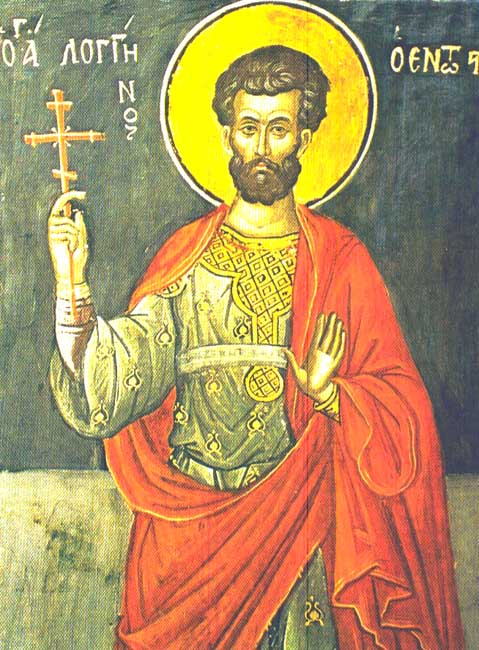 Saint Longinus lived during the time of Emperor Tiberius (15-34 AD). He is from Cappadocia (currently Turkey), and was serving in the Roman army in Palestine under the command of Governor Pilate with the rank of centurion. Divine providence intended for Longinus to be the supervisor of the crucifixion of Jesus. After Jesus gave up the spirit, the veil of the temple was torn in two, the earth shook, the rocks were split, and the graves were opened... (See Matthew 72). Longinus was afraid and said: “Indeed, this was the Son of God” (Matthew 27:54).
Saint Longinus lived during the time of Emperor Tiberius (15-34 AD). He is from Cappadocia (currently Turkey), and was serving in the Roman army in Palestine under the command of Governor Pilate with the rank of centurion. Divine providence intended for Longinus to be the supervisor of the crucifixion of Jesus. After Jesus gave up the spirit, the veil of the temple was torn in two, the earth shook, the rocks were split, and the graves were opened... (See Matthew 72). Longinus was afraid and said: “Indeed, this was the Son of God” (Matthew 27:54).
According to tradition, Longinus and two others were assigned to guard the tomb and they witnessed the events that preceded and followed the Resurrection. When the Jews wanted to bribe them, they left the army and fled to the Cappadocian country, the birthplace of Longinus, after they were baptized by the apostles.
The Jews feared that Longinus would expose them, so they incited Pilate to ask the emperor to order their prosecution and execution on charges of desertion. A group of soldiers set out to pursue them, but they did not know Longinus's location or description.
It happened that the soldiers stopped to rest where Longinus was staying, so he hosted them. During the conversation, the Tsar's workers revealed that they were searching for the fugitive centurion and his two companions. Longinus was certain that the hour of his martyrdom had approached. He honored them more, then let them sleep and began preparing himself for death.
Early the next morning, Longinus told his two companions what had happened, and the three agreed to reveal their identities to the soldiers and receive martyrdom. After that, Longinus revealed his identity to his students. They did not believe it at first, and their doubt turned into astonishment and sadness. After Longinus and his two companions insisted on carrying out the emperor’s will, the soldiers cut off their hams and sent them to Pilate at Longinus’ request after the Jews insisted that a sign be given to them confirming his death. When the Jews received the important thing and were sure that it was Lengenis, they threw it into a pit in which the city’s garbage was thrown.
Divine providence wants a rich, blind woman from the Cappadocian country - around the third century AD - to make a pilgrimage to the Holy Land, accompanied by her only son, and seek her recovery. As soon as she reached the city, her son died, leaving her sad. On that very night, Saint Longinus appeared to her in a dream, consoled her, promised her recovery, and saw her son crowned with glory in heaven. He asked her to search for his head and take it out of the garbage. The woman woke up and asked someone to take her to where the saint indicated and leave her alone there. So she started feeling the place with her hands and searching for the place herself, with Saint Longinus leading her. When she touched the saint, her eyes opened and she saw the saint as she saw her son next to the saint in heaven, and she was greatly comforted. So she returned to her country and built a church in which she placed the saint’s head and the body of her son.
We celebrate the saint on October 16.
Troparia in the fourth tune
Your martyr, O Lord, through his effort, obtained from you the indestructible crown, O our God, because he attained your strength, so he destroyed the usurpers and crushed the power of the demons who had no power. Through his supplications, O Christ God, he saved our souls.
Qandaq with the fourth tune
Today, the Holy Pledge of Allegiance is celebrated with joy, with the ever-remembrance of the warrior Longinus, and the cry is loud: You are my strength and my steadfastness, O Christ.


